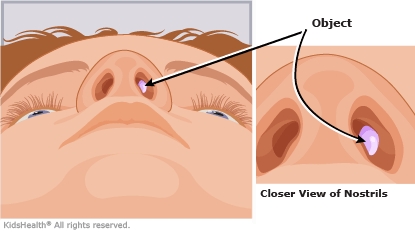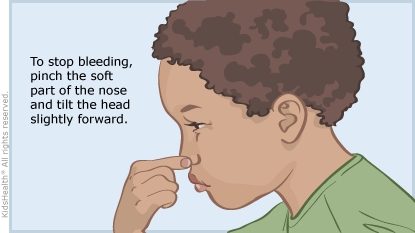How to Care for Your Child After Removal of an Object From the Nose
Sometimes, when a young child puts something in their nose, it can get stuck. An object left in the nose too long can cause itching, pain, bleeding, or an infection. The health care provider:
-
showed your child how to blow the object out of the nose or removed it
-
checked both nostrils for scratches and bleeding
-
looked for other stuck objects
Your child is ready to be cared for at home.


-
If your child has pain and your health care provider says it's OK, you can give acetaminophen (such as Tylenol® or a store brand) or ibuprofen (such as Advil®, Motrin®, or a store brand). Follow the directions on the label for how much to give and how often. Don't give ibuprofen to babies under 6 months old.
-
If your child's nose got infected, the health care provider prescribed an antibiotic. Give your child all the doses, even if they feel better. This is the best way to kill the harmful germs.
If a nosebleed happens:
-
Stay calm and comfort your child.
-
Have your child sit up and tilt the head slightly forward to keep blood from running down the back of the throat. It may help to have your child lean over a sink or pail to catch the blood. Don't put tissues or anything else inside the nose to catch the blood.
-
Have your child pinch the bottom, soft part of the nose together using their index finger and thumb. They should hold it without stopping for 10 minutes.
-
After 10 minutes, check for bleeding. If the nose is still bleeding, pinch the nose closed for another 10 minutes.


-
The nose is still bleeding after it has been pinched closed twice for 10 minutes each (as described above).
-
Drainage (blood or mucus) from the nose does not clear up in 3 to 5 days.
-
Your child is taking pain medicine but still has pain.
-
Your child has new or worse symptoms, such as fever, nasal drainage, face pain, or a headache.
-
Your child puts another object in their nose.

Can an object in the nose be dangerous? Yes, some objects can be dangerous. For example, button cell batteries (round flat batteries used in watches, toys, remote controls, and other devices) can cause burns inside the nose. Also, magnets put in the nose can pull toward each other, squeezing and causing damage to the part of the nose between the nostrils (the septum). An object in the nose also can get sucked in and go down the throat, possibly causing choking.
How can an object in the nose cause an infection? An object stuck in the nose (especially for a long time) can cause irritation that then gets infected. An infection in this part of the nose sometimes can move up into the sinuses (small hollow areas in the bones of the face) and other areas. If an infection happens, health care providers prescribe antibiotics to treat it.
How can I prevent my child from putting something in their nose again? Keep small objects (such as batteries, magnets, beads, earrings, crayons, and small toy parts) out of the reach of children. Tell your child that they should never put objects in their nose, ears, or any other body opening because they can get stuck. Adults should watch kids when they're around small objects at home, daycare, and preschool.